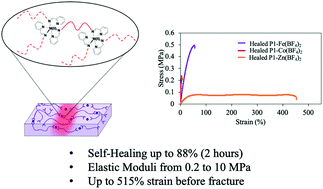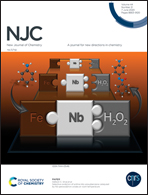Modulating the thermomechanical properties and self-healing efficiency of siloxane-based soft polymers through metal–ligand coordination†
Abstract
Short oligomeric species end-capped with imine-based ligands can generate intrinsic autonomous self-healable soft polymers upon metal coordination, allowing for the preparation of materials that can be easily fine-tuned in terms of mechanical properties and robustness. To develop a rational understanding of the self-healing mechanism on this system, an investigation of the fine-tuning of the self-healing efficiency by evaluating the metal used to induce crosslinking was performed. Moreover, the counter-ion used in the crosslinking system was also evaluated in order to probe its influence on the final thermomechanical properties. The resulting self-healing polymers were characterized by multiple techniques, including UV-Vis spectroscopy, tensile-strain pull testing, and shear rheology. The metal was shown to have a significant influence on the thermomechanical properties of the system, which can be directly attributed to the coordination geometry (crosslinking density) and bond strength. Moreover, the choice of the counterion used for crosslinking also showed a significant influence on the mechanical properties and self-healing efficiency. These results highlight the versatility of the end-capped polydimethylsiloxane (PDMS)-based system and provide valuable insights for the future development of self-healing polymers that can be produced on a large scale through solution processing, for a wide variety of applications.



 Please wait while we load your content...
Please wait while we load your content...